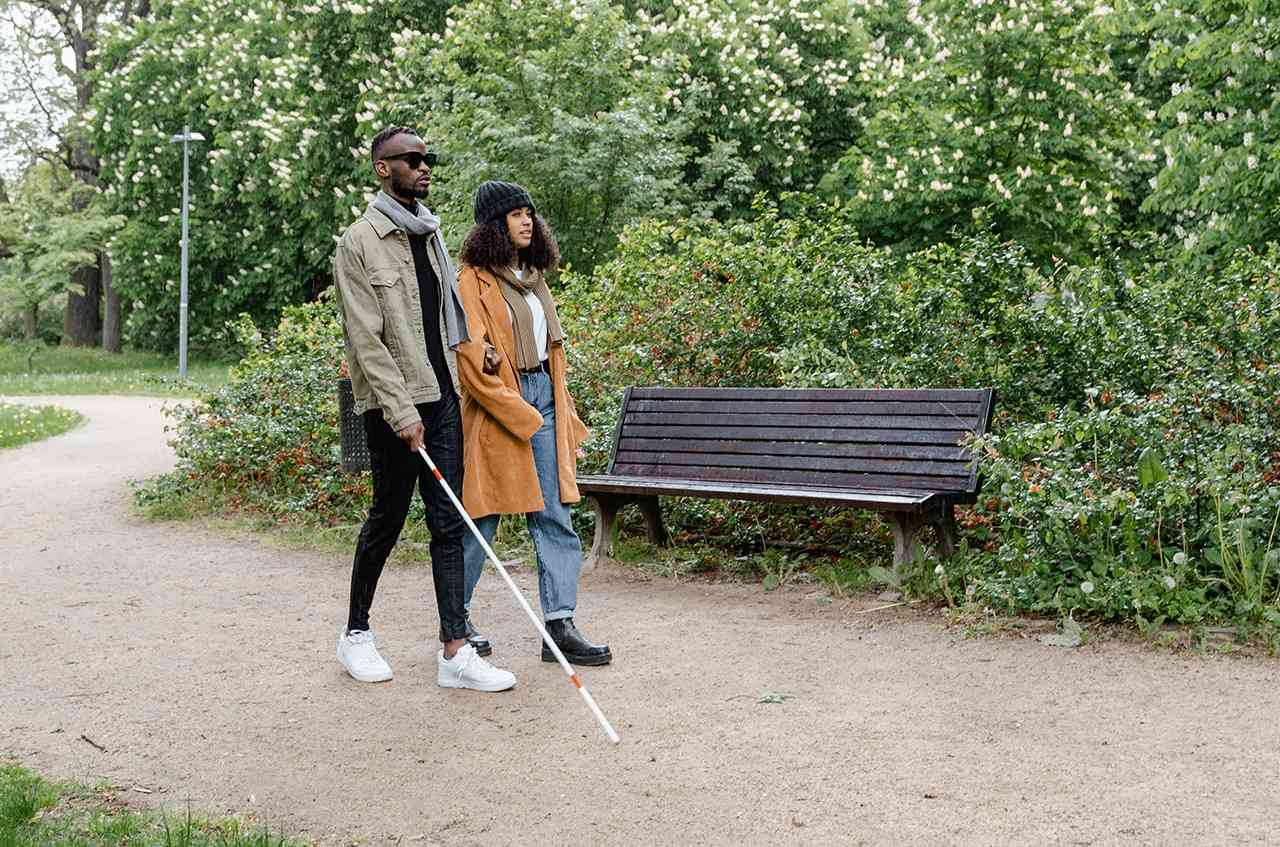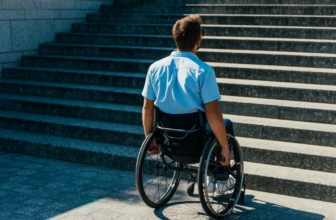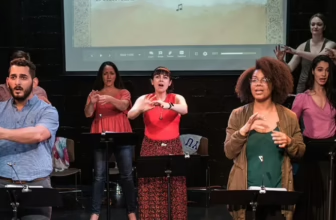So you've just found out you're going blind or have permanent vision loss. What do you do now?
Coping with vision loss is a new experience for most people, as you may have never even met a blind person before. Whether you've lost your vision due to an accident, illness, or disease, the news has probably left you shocked, confused, and afraid. Being diagnosed with a disability or a chronic illness of any kind can be difficult to accept. There is no way around it — this is a full-blown existential crisis that affects all aspects of your life and the lives of those close to you. Most people rely on their vision for just about everything in life — including walking around, reading, cooking, driving, and enjoying the beauty of nature.
Living with blindness or low vision requires learning a whole new set of skills, and may seem overwhelming at first. The good news is that there are lots of resources for help and information. With the right support, you can adapt to the changes in your eyesight and enjoy a full life regardless of your visual impairment.
This guide to living with vision loss will help you learn:
As an Amazon associate, we earn from qualifying purchases.
Dealing with the News of Visual Disability — What to Expect
The Five-Stage Model of Grief as Applied to Vision Loss
Dr. Elisabeth Kübler-Ross was a psychiatrist who studied the experiences of terminally ill and dying patients and described 5 stages of grief. The model was soon applied to many other contexts of dealing with life changes and significant losses. This model has received serious criticism, mostly based on the fact that each person’s grief and adaptation process is individual and can’t be put in a frame, and also, that it implies an expectation for linear progression of the phases, which is rarely the case in real life. Actually, Kübler-Ross herself noted that the stages are not linear and subsequent and that one can often experience a mixture of them. The model is valuable mostly because it provides information for patients that their experiences are normal and natural, and that they are not alone, and for caregivers and specialists on what to expect so that they can show empathy and understanding.
I will not go into details about the model, because it’s very famous and there is plenty of information on it online. For example, here you can read a detailed description of the phases and some other approaches to grief as well. Instead, I will focus on briefly summarizing each stage in the context of visual impairment and giving some tips on what can be done.
1. Denial
What it is: This is the first stage, directly after receiving the news of the impairment or disease. It may be the time right after an accident or a disease that progressed fast and resulted in permanent disability, or after an unsuccessful medical intervention. This is a stage of extreme shock — you just refuse to accept the diagnosis or maybe avoid the topic completely. It can’t be that bad, it can’t be permanent. Denial is a normal and healthy defense mechanism. It protects you from the immense shock, gradually letting you process only the amount of information you can handle.
What to do: It is of no use to talk about adapting and rehabilitation yet. The person with very recently sustained visual impairment is not prepared yet for this — their judgment and decisions at this time may not be adequate and rational. The only thing to do is try to calm down, relax, and prevent potentially harmful actions.
2. Anger
What it is: You gradually understand that the diagnosis is final and permanent and there hasn’t been a mistake. Anger is often expressed in blaming others for what has happened. The doctors haven’t done enough. They haven’t given you the right treatment, your family didn’t foresee the risks and didn’t prevent the disease from progressing, the caregivers aren’t doing their job right, and so on. People blame anyone and anything, from themselves and their loved ones, the doctors, scientists who haven’t discovered a cure yet, to the government and authorities, and even God, destiny, and supernatural powers.
What to do: Acknowledge these emotions and understand they are completely normal. Unlike total hopelessness and despair, anger provides a sense of direction. Allow for enough time and space to express them and be patient and tolerant. Anger is an important part of the healing process. It may seem like it will last forever, but when you feel, express, and acknowledge it, it will slowly start to decrease.
3. Bargaining
What it is: This stage is like being lost in a labyrinth of guilt, blame, and “what-ifs.” You focus on the past and go through everything that could have happened differently. What if the disease was discovered sooner, what if the accident could have been prevented, what if you haven’t done this and that. Bargaining also can relate to the current situation, not just the past. Maybe if you devote your life to God, or to serving others, a miracle will happen that can change and reverse the disability. Maybe if you take lots of care of your health or try some alternative medication, your eyesight may improve.
What to do: Understand that bargaining is a normal stage of healing and adaptation. It is a way to cope with the helplessness and give yourself hope that something can be done, even if you are focusing on the past. It provides a sense of control and responsibility for the situation. Share these thoughts with your family, friends, or a therapist — they can provide a more rational perspective. Be wary of charlatans and scammers who may try to take advantage of you and offer you pseudo-scientific “cures”!
4. Depression
What it is: This is the stage when one comes to terms with reality and understands the impact of what has happened. Withdrawal, isolation, hopelessness, and deep sadness are typical and normal experiences during this stage. People usually stop caring about themselves during this stage. They may stop bathing, grooming, and caring for themselves, and appear uninterested, passive, and isolated. The depressive stage is a normal part of the healing process and a path to acceptance.
What to do: It’s a good time to contact a therapist, counselor, or mental health specialist. It is also important that you keep caring for your physical health, and be gentle to yourself. The family and loved ones of the person with a recent visual disability should not leave them lonely and neglected for a long time and should try to provide positive experiences as much as they can — for example, going out on short walks, communicating with friends, discussing things of interest.
5. Acceptance
What it is: Acceptance doesn’t mean being happy and “getting over” it. It can manifest itself in a mixture of emotions. It just means that you understand what happened and you are learning to live with it.
What to do: This is the time to start researching rehabilitation services and training programs to help you adapt to the new situation. Getting in contact with other people with impaired vision is also very valuable as they can give you hope, advice, and a good example.
Will other senses compensate for the vision loss?
Myths and facts about sensory compensation
Is it true that blind people have a stronger sense of hearing and echolocation? Does vision loss mean other senses, such as tactility, hearing, and smell, will automatically enhance in order to compensate? Are people with impaired vision better at memorizing things? Or is this all a myth? The short answer is: we don't know for sure. Sensory and cognitive compensation in people with impaired vision has been a mystery for decades and numerous studies have been conducted, with divergent and often opposing results.
Here are some examples of interesting studies and reviews, in case you are curious.
Here is an overview, with examples, of the two main theories on blindness and the compensatory role of other senses: “(1) blindness may lead to compensation of the other senses; (2) early blindness may halt the development of perceptual and cognitive mechanisms, disallowing the other senses to compensate.” According to the authors, the loss of vision may be compensated by the other senses, especially when it occurs at an early age.
This study of blind adults showed evidence for compensatory changes in long-term memory and proof of the “high adaptive capabilities of the human cognitive system.”
This study suggests that blind children have “an advantage in tasks that assess nonvisual memory” and “sighted children rely on visualization as a strategy to aid their performance on the cognitive tasks, and are disadvantaged when these strategies cannot be utilized.”
Here it is demonstrated how losing one eye at an early age may result in “super functioning” in the remaining eye.
However, this paper discusses that people with blindness are not “‘super-sensors’ in non-visual modalities, and may even be worse off than sighted individuals.”
When we talk about sensory compensation for vision loss, we usually mean mostly hearing and tactile perception. Studies have been conducted on the sense of smell too, such as this and this one. They found no significant differences between sighted and blind individuals, but the latter study concluded that people with blindness may rely more on their sense of smell than sighted people.
What should I remember about compensation for vision loss?
So, what does all that mean for you? Let’s try to sum up the most important and practical conclusions, that we can use in improving your situation.
1. You have what it takes.
Our bodies naturally possess the ability to compensate for missing or worsened functions. Compensation starts automatically and involuntarily. For example, you don’t need to spend days and weeks wondering what to do if one of your legs is injured and you are wearing a cast. You automatically start using your healthy leg more and supporting part of your weight with your arms on the crutches when walking. When you lose your vision completely, you will soon start paying more attention to the sounds in your surroundings and try to use the input for orientation and information. This means, that in the process of training and rehabilitation, we — teachers, psychologists, or other specialists, will only help you discover what you already have. Evolution (or if you prefer, Nature or God) has already equipped you with everything you need to adapt to this situation. We will only show you some tools and methods on how to use and develop these skills.
2. Patience and practice.
Compensation is a gradual process. We can’t expect a person who lost their vision a week ago to train their other senses to a high level of functioning in such a short time. This process needs time and lots of practice. This is why it’s important not to rush yourself. Be curious about how your senses and your brain work, ask questions to your teachers, explore, and experiment.
3. Don’t compare yourself to others.
Compensation depends on combining many factors, such as age, severity of the vision loss, general physical and mental health, personality traits, motivation, supportive circle, previous experience, access to rehabilitation services, and many others. Each person with vision loss adapts and learns at their own pace.
4. Compensation doesn’t mean replacement.
Compensation is a complex and multisensory process of integration and interaction of modalities in the cortex. Expecting to replace the sense of sight with something that will take its functions and work like before is unrealistic. Compensation is much more than that — it involves integrating the information from all the other senses, plus cognitive functions, knowledge, and experience, all put together. The purpose of rehabilitation is not to restore life as it was before the disability, but rather to establish a new lifestyle and discover new perspectives for growth and wellbeing.
5. Learning and rehabilitation are worth it.
Neuroplasticity, or the ability of our brains to rewire and construct new neural networks and connections, is greatly responsive to learning, experience, and exercise. Just like our body responds to physical exercise by improving strength, endurance, agility, etc., the brain also responds to studying, training, and practicing. And just like physical strength, we can’t expect to see results immediately, but when we are consistent in our efforts, results will come.
What is basic rehabilitation for vision loss?
Basic or elementary rehabilitation is a set of services for people with vision loss that includes teaching, training, and sometimes therapeutic activities. The purpose is so the person with a visual disability can acquire practical and useful skills of independence. Depending on the facility that provides these services, or the theoretical frame in pedagogy for the visually impaired we use, there can be some differences in the subjects considered to be basic rehabilitation. I will mention the most common ones, which are absolutely necessary for independent living.
Orientation & Mobility
Orientation and Mobility, together with Daily Living Skills, are the most important subjects for a person with visual impairment and should be the things your training rehabilitation program starts with. Orientation and Mobility mean teaching you how to move independently and safely indoors and outdoors, how to use your senses of hearing, touch, echolocation, temperature, and smell to determine your location, how to use a white cane, how to use public transport, apps and GPS, as well as some safety techniques when moving independently, sighted guide techniques, and everything related to finding orientation marks and obstacles and navigating through the environment.
Daily Living Skills
This subject has many names: Daily Living Skills, Functional Skills, Independent Living Skills, Organizational Skills, and Everyday Skills. It includes a very wide range of skills, divided into several groups:
- Concepts of space, shapes, sizes, colors, substances, and body awareness. Teaching these concepts and skills is necessary for children who were born blind or sustained a visual disability at a very early age. People whose visual impairment happened later in life already have these concepts and will not need this part of the training.
- Practical skills for everyday life. This means hygiene, personal care, dressing, cosmetics, domestic chores like laundry, dishwashing, cooking, cleaning, organizing, and keeping your home orderly, clean, and cozy. It also includes learning how to adapt your home and label products using tactile stickers, bright-colored stickers, floor marking safety tape, or a Braille labeler.
- Skills for shopping, recognizing money, signing, familiarizing oneself with institutions and facilities, and also skills to introduce yourself, ask for help, or refuse help.
- Skills for time management and organizing leisure time, finding hobbies and interests, and participating in social groups and circles. This may also include visiting museums, theaters, or cinemas.
Vision Rehabilitation / Low Vision Therapy
For people with low vision, this kind of therapy means learning how to use and exercise their low vision so that it functions optimally. Vision therapy can’t physically restore the eyes or optical nerves, but it can improve their function with exercises for coordination, focusing, following, differentiation of contrast and colors, adapting to light and shade, and many other techniques and activities, depending on the individual's needs. It also includes training and testing the use of various devices for low vision, such as special lamps and electronic devices for reading, such as a portable magnifier or magnifying glasses.
Activities and Hobbies for People with Vision Loss
There are so many fun activities and hobbies you can enjoy as a blind person. Check out our guides:
- Sports can be made accessible for people with partial or full blindness.
- Board games and card games come in blind and low-vision-friendly versions so you can play with blind and sighted friends.
Access to Technology for People with Vision Loss
With the advancement of technologies, people with visual impairments have a chance to learn computer and digital skills on a very high and even professional level. The training in computer and technological skills will teach you how to use screen reading and voice recognition software, how to adapt the display for low vision, how to use a Braille display, Braille supporting software, keyboard combinations, touchscreen, and gestures, and many other options and features.
Who provides rehabilitation services?
Depending on where you live, there may be different government-funded or charity-based facilities, providing services and training for people with visual impairment. Google search “your state + vision rehabilitation” “your state + blind services,” or “your state + agency for blind.” Here are some resources and examples:
- American Council of the Blind
- American Foundation for the Blind
- Handbook of Resources and Services for Persons who are Blind or Visually Impaired
- North Carolina Department of Health and Human Services Department for the Blind
- Washington State Department of Services for the Blind
Books and Resources for Coping with Vision Loss
Photo by MART PRODUCTION
My name is Iva and I am a beginner freelance writer and translator.
I have a Master’s degree in counseling psychology and a Master’s degree in Education for people with visual disabilities.
For over 10 years I have been working as a psychologist and educator, mostly, but not only, in the field of education and social inclusion of people with visual disabilities.
I am an Orientation and Mobility teacher and a Basic Rehabilitation instructor.
I hope writing can help me reach out to more people and share my experience and knowledge with them.










